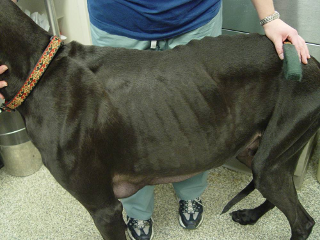A too high level of calcium in the blood (can be the case with ao lymphoma (10-36%), anal sac carcinoma (25%), thyroid carcinoma, multiple myeloma (20%), bone tumour, thymoma, squamous cell carcinoma, (adeno)carcinoma of the mammary gland, melanoma, primary tumour of the lungs, chronic lymphocytic leukemia, renal angiomyxoma, parathyroid tumour). An increase in blood calcium can have many causes (ao metastases towards the bone, an increased level of parathyroid hormones, … ) and can cause following symptoms:
- Inability to concentrate urine
- Residu of calcium salts in the kidney causing renal damage
- Breakdown of the epithelium (lining) of the urinary tract
- Drink and urinate a lot, which can lead to dehydration
- Constipation, elevated blood pressure, involuntary muscle contractions, weakness, depression, vomiting, low cardiac rhythm, becoming slower, coma, death.


